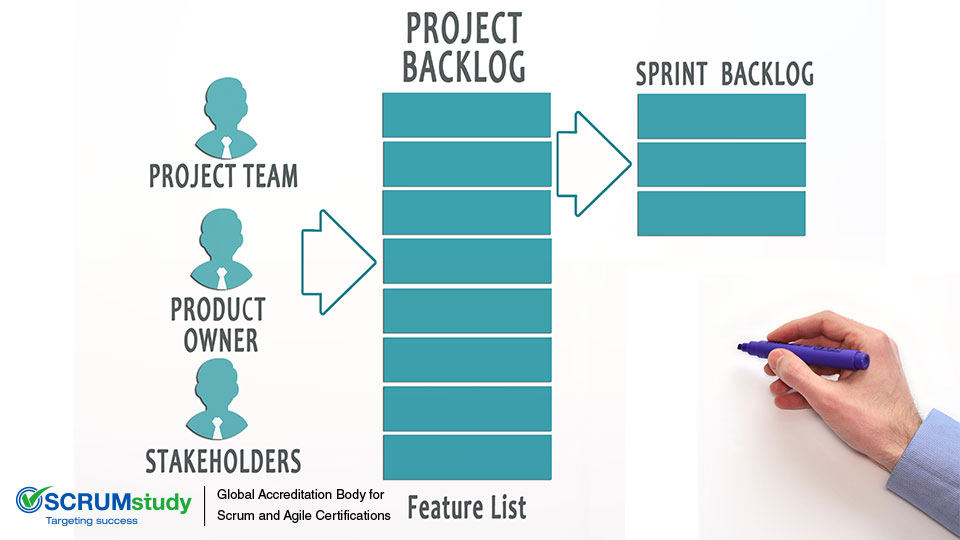Agile Scrum sprint backlog grooming
Posted by SCRUMstudy® on July 09, 2024
Categories: Agile Product Backlog SBOK® Guide Scrum Sprint Backlog
Agile Scrum sprint backlog grooming, also known as backlog refinement, is an ongoing process where the Scrum team collaborates to review and prioritize items in the product backlog. This activity typically involves discussing the scope, requirements, and acceptance criteria of user stories, as well as estimating the effort needed to complete them. By refining the backlog, the team ensures that the highest priority items are well-understood and ready for future sprints, thereby improving planning efficiency and helping to maintain a steady flow of work. Regular grooming sessions help the team stay aligned with project goals and adapt to changing requirements.
Agile Leadership Certification Growth represents a dynamic journey of professional development and evolution within the realm of agile leadership. It encompasses the process of acquiring foundational knowledge, honing practical skills, and mastering advanced competencies required to lead agile teams and organizations effectively. As individuals progress through certification levels and gain practical experience, they demonstrate a deepening understanding of agile methodologies, principles, and best practices.
The Agile Leadership Certification empowers leaders with the knowledge and skills to effectively guide their teams in agile environments. This certification focuses on developing a deep understanding of agile principles, practices, and methodologies, enabling leaders to foster a culture of continuous improvement and innovation. Through comprehensive training and practical application, certified agile leaders learn to facilitate collaboration, enhance productivity, and drive successful project outcomes. By earning this certification, leaders demonstrate their commitment to agile excellence and their ability to inspire and lead teams in a rapidly evolving business landscape. This credential is essential for those aiming to excel in agile project management and leadership roles.
The Agile Leadership Certification is a prestigious credential that underscores the value of effective leadership in Agile environments. This certification equips leaders with the knowledge and skills necessary to drive Agile transformation and cultivate high-performing teams.
How important is Continuous Value Justification in a Scrum Project?
Every project is expected to create some form of business value that outweighs the associated costs
and risks in order for it to be undertaken. But what is business value? And how can one ensure
that the project delivers business value on the expected lines? Business value can be looked at
in financial or non-financial terms such as reduction in costs, increase in revenue, enhancement
in brand value, and increase in satisfaction level among customers, reduction in the number of
complaints, reduction in risks or improvement in organizational capability, etc.
To ensure realization of business value, Scrum relies on continuous value justification. Continuous
value justification refers to assessment of business value regularly to determine whether the
justification or viability of executing the project continues to exist. Business value should be assessed
regularly to determine whether the justification or viability of executing the project continues to
exist. Frequent assessment of investment in the project relative to business value being created
qualifies the continued viability of a project. The expected requirements from the project may
change frequently, which can impact both project investment and value creation.
A key aspect of Scrum is its ability to quickly adjust to chaos created by a rapidly changing business
model. In projects with ambiguous user requirements and significant potential for frequent changes,
Scrum provides considerable advantages over other project delivery models. Monitoring the rate of
delivering value is an important requirement for Scrum projects. Periodically tracking and reporting
the creation of value assists in assessing project status and provides important information to the
customer and other Business stakeholders. Hence, continuous value justification plays a vital role in the key
decision making processes related to the project.
Agile Scrum sprint backlog
Posted by SCRUMstudy® on June 22, 2024
Categories: Agile Certification Scrum Training
The Agile Scrum sprint backlog is a pivotal artifact that embodies the essence of collaborative planning and iterative development within Scrum projects. It serves as a comprehensive plan for the Sprint, detailing the specific work items, user stories, and tasks identified during Sprint Planning. The sprint backlog is meticulously crafted by the Scrum Team, typically under the guidance of the Product Owner, who ensures that the highest priority items are at the forefront. This backlog not only outlines what needs to be accomplished in the Sprint but also acts as a dynamic document that evolves as the team gains insights and progresses through daily stand-ups and other collaborative sessions. By focusing on transparency and adaptability, the sprint backlog facilitates efficient communication and alignment within the team, ultimately driving the incremental delivery of valuable product increments.
It is often seen that Agile has been implemented successfully in different projects. But when it comes to Product Management or NPD (New Product Development), many people get sceptical regarding implementation of Agile. Now it has to be understood that Agile is not a methodology which can be used in a cookie cutter way across any organization. A lot of tweaking and customization is required to make it work. So, in product management, a proper assessment is required to see if Agile implementation will improve performance or not.
Here also, we need to see if the following two criteria are being fulfilled or not:
- Requirement Volatility : It is important to identify the volatility of requirements and whether working in Sprint will actually improve customer satisfaction, reduce uncertainty and help PM teams become more productive or not. If requirements are fixed in sand and are not dynamic in nature, it will not make any marked improvement even if the teams work in sprint. Also, Agile Product Life Cycle Management involves a lot of new learning, so it needs to be checked if the team will be comfortable in this transition or not.
- Frequent customer Interaction: External customers are big stakeholders in any Agile effort. In many product management scenarios, we have seen that customers just give their specifications and just go away for months and months. And finally when they come back for the product, it is completely different from what they expected, because market dynamics change and the expectations change as well. So the biggest benefit is actually to the customers themselves, and this is what the PM team should explain in details to the customers so as to get their buy in. Without their pro-active support, it will not be possible to implement Agile in any way.
If we are talking about New Product Development, then Agile actually becomes even more crucial and important. That is because neither the customers nor the PM team has any benchmark to follow. So, frequent discussions and brain storming sessions followed by change in requirements or prototypes will be mandatory for successful NPD. So, it is important to realize that Agile can be implemented successfully in Product Management as well, provided it is understood properly and used in the proper context. Also, management buy-in and customer buy-in are important components in this scenario, and a good AGILE coach will also be very beneficial.
Agile Scrum sprint backlog refinement
Posted by SCRUMstudy® on August 22, 2023
Categories: Agile Product Backlog Product Development Scrum Sprint
Product backlog refinement in Scrum involves several key steps to ensure clarity and prioritization. Initially, the product owner collaborates with the team to review and adjust backlog items, ensuring they are clear, concise, and aligned with the product vision. Next, they prioritize items based on value and dependencies, refining estimates and acceptance criteria as needed. Throughout this iterative process, stakeholders provide input to enhance understanding and feasibility. The goal is to maintain a dynamic backlog that reflects current priorities and evolves with feedback, fostering a shared understanding among all team members for efficient sprint planning and delivery.
What is a Sprint Backlog? Is it a baseline, a record or a report? Baseline is a project document, which, defines aspects of the project and, once approved, is subject to change control. It is used to measure a project’s actual performance as against planned targets. A record maintains information on the progress of the project. A report provides snapshots of the status of different aspects of a project at any given point of time or for a given duration.
To answer this question, we need to understand what a Sprint Backlog is, its purpose and composition. The Scrum Team creates the Sprint Backlog and Sprint Burndown Chart using the User Stories, and the Updated Task List during Sprint Planning Meeting. During Sprint Planning Meeting, the User Stories, which are approved, estimated, and committed during the Create, Estimate, and Commit User Stories process, are taken up for discussion by the Scrum Team. Each Scrum Team member also uses Updated Task List to select the tasks they plan to work on in the Sprint, based on their skills, and experience. The list of the tasks to be executed by the Scrum Team in the upcoming Sprint is called the Sprint Backlog.
It is common practice in Scrum that the Sprint Backlog is represented on a Scrumboard or task board, which provides a constantly visible depiction of the status of the User Stories in the backlog. Also included in the Sprint Backlog are any risks associated with the various tasks. Any mitigating activities to address the identified risks would also be included as tasks in the Sprint Backlog. Once the Sprint Backlog is finalized and committed to by the Scrum Team, new user stories should not be added – however, tasks that might have been missed or overlooked from the committed user stories may need to be added. If new requirements arise during a Sprint, they will be added to the overall Prioritized Product Backlog and included in a future Sprint, depending on their criticality, and urgency.
Another tool associated with the Sprint Backlog is the Sprint Burndown Chart. It is a graph that depicts the amount of work remaining in the ongoing Sprint. The initial Sprint Burndown Chart is accompanied by a planned burndown. The Sprint Burndown Chart should be updated at the end of each day as work is completed. This chart shows the progress that has been made by the Scrum Team and also allows for the detection of estimates that may have been incorrect. If the Sprint Burndown Chart shows that the Scrum Team is not on track to finish the tasks in the Sprint on time, the Scrum Master should identify any obstacles or impediments to successful completion, and try to remove them. A related chart is a Sprint Burnup Chart. Unlike the Sprint Burndown Chart which shows the amount of work remaining, the Sprint Burnup Chart depicts the work completed as part of the Sprint.
So, it is difficult to categorize the Sprint Backlog as a baseline, record or a report. And as Scrum professes minimum documentation, Sprint Backlog fulfills purposes of more than one project document. For more information on Scrum framework, you can read the Scrum Body of Knowledge (SBOK Guide). It can be downloaded for free in SCRUMstudy website: http://www.scrumstudy.com/download-free-buy-SBOK.asp
Agile Scrum Sprint Backlog Management
Posted by SCRUMstudy® on June 21, 2023
Categories: Agile SBOK® Guide Scrum Scrum Guide Sprint Backlog
What is a Sprint Backlog? Is it a baseline, a record or a report? Baseline is a project document, which, defines aspects of the project and, once approved, is subject to change control. It is used to measure project’s actual performance as against planned targets. A record maintains information on the progress of the project. A report provides snapshots of the status of different aspects of a project at a given point of time or for a given duration.
To answer this question, we need to understand what a Sprint Backlog is, its purpose and composition. The Scrum Team creates the Sprint Backlog and Sprint Burndown Chart using the User Stories and the Effort Estimated Task List during Sprint Planning Meeting. During Sprint Planning Meeting, the User Stories, which are approved, estimated, and committed during the Approve, Estimate, and Commit User Stories process, are taken up for discussion by the Scrum Team. Each Scrum Team member also uses Effort Estimated Task List to select the tasks they plan to work on in the Sprint, based on their skills and experience. The list of the tasks to be executed by the Scrum Team in the upcoming Sprint is called the Sprint Backlog.
It is common practice in Scrum that the Sprint Backlog is represented on a Scrumboard or task board, which provides a constantly visible depiction of the status of the User Stories in the backlog. Also included in the Sprint Backlog are any risks associated with the various tasks. Any mitigating activities to address the identified risks would also be included as tasks in the Sprint Backlog. Once the Sprint Backlog is finalized and committed to by the Scrum Team, new user stories should not be added – however, tasks that might have been missed or overlooked from the committed user stories may need to be added. If new requirements arise during a Sprint, they will be added to the overall Prioritized Product Backlog and included in a future Sprint.
Another tool associated with the Sprint Backlog is the Sprint Burndown Chart. It is a graph that depicts the amount of work remaining in the ongoing Sprint. The initial Sprint Burndown Chart is accompanied by a planned burndown. The Sprint Burndown Chart should be updated at the end of each day as work is completed. This chart shows the progress that has been made by the Scrum Team and also allows for the detection of estimates that may have been incorrect. If the Sprint Burndown Chart shows that the Scrum Team is not on track to finish the tasks in the Sprint on time, the Scrum Master should identify any obstacles or impediments to successful completion, and try to remove them. A related chart is a Sprint Burnup Chart. Unlike the Sprint Burndown Chart which shows the amount of work remaining, the Sprint Burnup Chart depicts the work completed as part of the Sprint.
So, it is difficult to categorize the Sprint Backlog as a baseline, record or a report. And as Scrum professes minimum documentation, Sprint Backlog fulfills purposes of more than one project document.
In Agile Scrum, effective Sprint Backlog management is crucial for achieving project goals efficiently. The Sprint Backlog, derived from the Product Backlog, lists the tasks that the Scrum Team commits to completing during a Sprint. Managed by the Scrum Master, this dynamic document evolves as new insights emerge and priorities shift. It serves as a guiding tool during Daily Standups, ensuring transparency and focus on the Sprint goal. By continuously refining and updating the Sprint Backlog, teams maintain agility, adaptability, and clarity throughout the Sprint cycle, ultimately delivering valuable increments of work at the end of each iteration.
For more information on Scrum framework, you can read the Scrum Body of Knowledge (SBOK Guide). It can be downloaded for free in SCRUMstudy website: http://www.scrumstudy.com/download-free-buy-SBOK.asp




